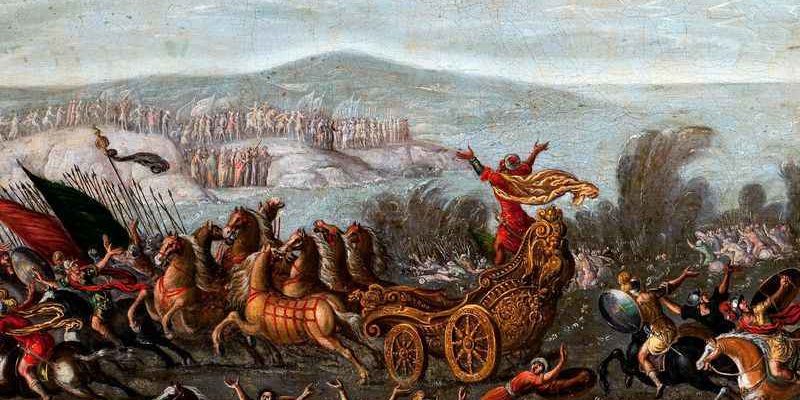
Themes and Typology in Exodus
Many biblical patterns receive attention in the book of Exodus, so many that it would be difficult to put together the rest of the Bible without it. Covenant, salvation, the ten commandments, knowing God through self-revelation, Israelite institutions like the Feast of Unleavened Bread and Passover, and other themes find their introduction in Exodus. For this reason, scholars have stated, “Exodus could be considered the central book in the Old Testament”[1] for “it lays the foundation for a theology of God’s revelation of his person, his redemption, his law, and his worship.”[2] With “over 120 explicit Old Testament references to the Exodus in law, narrative, prophecy, and psalm…it is difficult to exaggerate its importance.”[3] The ordinances of baptism and the Lord’s Supper find their OT counterpart in the book of Exodus. Christ is posited as the true Moses (Mt 5–7), the true Israel (Mt 2:13–15), the true tabernacle (Jn 1:14), the giver of true manna (Jn 6:35), and the ultimate Passover Lamb (Mt 26:28). Christ is posited as the true Moses (Mt 5–7), the true Israel (Mt 2:13–15), the true tabernacle (Jn 1:14), the giver of true manna (Jn 6:35), and the ultimate Passover Lamb (Mt 26:28). Click To Tweet Christ’s church is restored Israel (1 Pet 2:9). Exodus provides a map that helps the reader understand the landscape of the biblical story.
Themes in Exodus
By viewing themes across books in the Bible, one is able to discern the collective intent of the biblical authors—or more simply, what God does not want us to miss. Several themes should be noted in reading Exodus. One such theme is salvation. Deliverance from physical bondage in Egypt corresponds to deliverance from spiritual bondage through Christ (Jn 8:34–36; Rom 6:6, 17, 20). The Passover lamb of Exodus 12 points beyond itself to Christ. He is the Lamb without blemish who was slaughtered in the place of guilty sinners. Salvation is by grace alone through faith alone (12:3; Eph 2:8).
Second, the covenant with Israel, also known as the Sinai or Mosaic covenant, is established. The covenant is entered after deliverance from Egypt (Ex 2:23-25; 20:2; 24), stipulated in blessings and curses (Ex 20; 24:7; Lev 26; Deut 26-28), deposited in the temple (Ex 25:16), sealed with a meal (Ex 24:9-11), and marked by the Sabbath (Ex 20:8-11; Deut 5:12-16). Exodus opens with the Lord remembering His covenant promises to Abraham (2:24; 3:6; 14-17; 6:2-8). As the book progresses, Moses testifies to the actualization of God’s promise of descendants to Abraham (1:6; 12:37–38). Clear in Exodus is that no world power is strong enough to thwart the fulfillment of God’s promises. The seed of the woman will crush the snake (Gen 3:15); a king will come from Judah (Gen 49:9); the people of God will still a land (Gen 12:1–4). God fulfills every promise.
Furthermore, the character and worship of God are brightly displayed in Exodus. He is “I AM” (Ex 3:14), “the God of Abraham, the God of Isaac, and the God of Jacob” (3:7–10, 16–17), a jealous God (34:14). His sovereignty is evident in His interaction with Pharaoh. Psalm 105:25 reads, the Lord “turned [the Egyptians’] hearts to hate his people, to deal craftily with his servants.” The Lord spoke to Moses and proclaimed,
The LORD, the LORD, a God merciful and gracious, slow to anger and abounding in steadfast love and faithfulness, keeping steadfast love for thousands, forgiving iniquity and transgression and sin, but who will by no means clear the guilty, visiting the iniquity of the fathers on the children and the children’s children, to the third and fourth generation (34:6–7).
Because the God of Israel is the only true God, people are to worship Him alone. The supremacy of God is fundamental to the ten commandments (20:4–6) and why considerable space is given to the tabernacle (25:1–31:18; 35:1–40:38). Tabernacle is used fifty-five times in Exodus, encompassing almost half of the book and emphasizing God’s presence with His people. As Longman explains, “the tabernacle was very costly in time, effort, and monetary value; yet in its significance and function it pointed to the chief end of humankind: to glorify God and to enjoy him forever.”[4]
Typology in Exodus
In Exodus, what persons, events, or institutions point beyond itself in the biblical storyline? Several patterns can be analyzed. First, Jesus is the Passover Lamb foreshadowed in the first Passover meal (Jn 1:29; 1 Cor 5:7; 1 Pet 1:18–19) and the true Israel who journeyed to Egypt (Mt 2:15; cf. Hos 11:1). Exodus provides the second typological firstborn son, Isaac being the first (Gen 22), whose life is spared through sacrifice. Christ is the true covenant mediator (cf. Ex 19:16–20; Heb 8:6–13) who comes from the house of Levi (Ex 2:1) to serve as prophet (Heb 1:2) and permanent priest (Heb 7:26–27). Israel, as the physical “kingdom of priests” and “holy nation” (19:6), is restored in the NT as the spiritual people of God (Eph 1:14; 1 Pet 2:9), the Church. With this in mind, church ordinances are viewed in the NT as the antitype of the Israelites’ passage through the Red Sea (baptism; 1 Cor 10:1–3) and the Feast of Unleavened Bread (Lord’s Supper; Lk 22:20; 1 Cor 11:23–26; cf. Ex 24:8). The Church now travels toward the promise land (Heb 11:10) and awaits a city that has no temple (Rev 21:22). There, Christians will sing the song of Moses (Rev 15:3–4).
Endnotes
[1] Dorian G. Coover-Cox, Exodus, in CSB Study Bible (Nashville: Holman Bible, 2017), ed. Trevin Wax, 89.
[2] Walter C. Kaiser Jr., “Exodus,” in The Expositors Bible Commentary (Grand Rapids: Zondervan, 2008), vol 1, ed. Tremper Longman III and David E. Garland, 341–342.
[3] Rikki Watts, “Exodus,” in Desmond Alexander and Brian Rosner, ed. New Dictionary of Biblical Theology (Downers Grove: Intervarsity Press, 2000), 478.
[4] Tremper Longman III, How to Read Exodus (Downers Grove: Intervarsity, 2009), 163.

